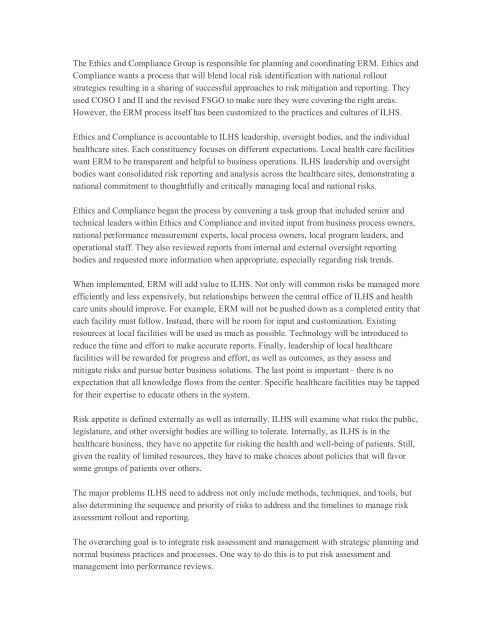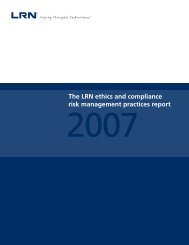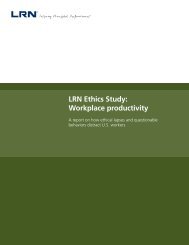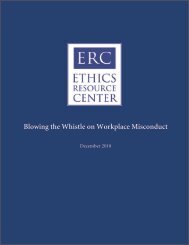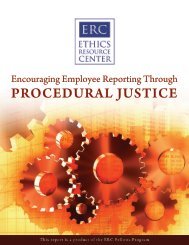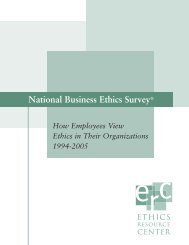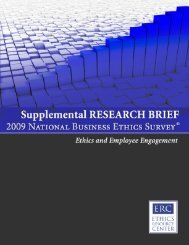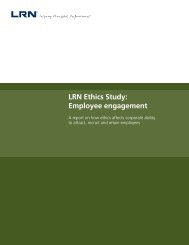enterprise risk management: why the ethics and compliance function ...
enterprise risk management: why the ethics and compliance function ...
enterprise risk management: why the ethics and compliance function ...
Create successful ePaper yourself
Turn your PDF publications into a flip-book with our unique Google optimized e-Paper software.
The Ethics <strong>and</strong> Compliance Group is responsible for planning <strong>and</strong> coordinating ERM. Ethics <strong>and</strong><br />
Compliance wants a process that will blend local <strong>risk</strong> identification with national rollout<br />
strategies resulting in a sharing of successful approaches to <strong>risk</strong> mitigation <strong>and</strong> reporting. They<br />
used COSO I <strong>and</strong> II <strong>and</strong> <strong>the</strong> revised FSGO to make sure <strong>the</strong>y were covering <strong>the</strong> right areas.<br />
However, <strong>the</strong> ERM process itself has been customized to <strong>the</strong> practices <strong>and</strong> cultures of ILHS.<br />
Ethics <strong>and</strong> Compliance is accountable to ILHS leadership, oversight bodies, <strong>and</strong> <strong>the</strong> individual<br />
healthcare sites. Each constituency focuses on different expectations. Local health care facilities<br />
want ERM to be transparent <strong>and</strong> helpful to business operations. ILHS leadership <strong>and</strong> oversight<br />
bodies want consolidated <strong>risk</strong> reporting <strong>and</strong> analysis across <strong>the</strong> healthcare sites, demonstrating a<br />
national commitment to thoughtfully <strong>and</strong> critically managing local <strong>and</strong> national <strong>risk</strong>s.<br />
Ethics <strong>and</strong> Compliance began <strong>the</strong> process by convening a task group that included senior <strong>and</strong><br />
technical leaders within Ethics <strong>and</strong> Compliance <strong>and</strong> invited input from business process owners,<br />
national performance measurement experts, local process owners, local program leaders, <strong>and</strong><br />
operational staff. They also reviewed reports from internal <strong>and</strong> external oversight reporting<br />
bodies <strong>and</strong> requested more information when appropriate, especially regarding <strong>risk</strong> trends.<br />
When implemented, ERM will add value to ILHS. Not only will common <strong>risk</strong>s be managed more<br />
efficiently <strong>and</strong> less expensively, but relationships between <strong>the</strong> central office of ILHS <strong>and</strong> health<br />
care units should improve. For example, ERM will not be pushed down as a completed entity that<br />
each facility must follow. Instead, <strong>the</strong>re will be room for input <strong>and</strong> customization. Existing<br />
resources at local facilities will be used as much as possible. Technology will be introduced to<br />
reduce <strong>the</strong> time <strong>and</strong> effort to make accurate reports. Finally, leadership of local healthcare<br />
facilities will be rewarded for progress <strong>and</strong> effort, as well as outcomes, as <strong>the</strong>y assess <strong>and</strong><br />
mitigate <strong>risk</strong>s <strong>and</strong> pursue better business solutions. The last point is important– <strong>the</strong>re is no<br />
expectation that all knowledge flows from <strong>the</strong> center. Specific healthcare facilities may be tapped<br />
for <strong>the</strong>ir expertise to educate o<strong>the</strong>rs in <strong>the</strong> system.<br />
Risk appetite is defined externally as well as internally. ILHS will examine what <strong>risk</strong>s <strong>the</strong> public,<br />
legislature, <strong>and</strong> o<strong>the</strong>r oversight bodies are willing to tolerate. Internally, as ILHS is in <strong>the</strong><br />
healthcare business, <strong>the</strong>y have no appetite for <strong>risk</strong>ing <strong>the</strong> health <strong>and</strong> well-being of patients. Still,<br />
given <strong>the</strong> reality of limited resources, <strong>the</strong>y have to make choices about policies that will favor<br />
some groups of patients over o<strong>the</strong>rs.<br />
The major problems ILHS need to address not only include methods, techniques, <strong>and</strong> tools, but<br />
also determining <strong>the</strong> sequence <strong>and</strong> priority of <strong>risk</strong>s to address <strong>and</strong> <strong>the</strong> timelines to manage <strong>risk</strong><br />
assessment rollout <strong>and</strong> reporting.<br />
The overarching goal is to integrate <strong>risk</strong> assessment <strong>and</strong> <strong>management</strong> with strategic planning <strong>and</strong><br />
normal business practices <strong>and</strong> processes. One way to do this is to put <strong>risk</strong> assessment <strong>and</strong><br />
<strong>management</strong> into performance reviews.


